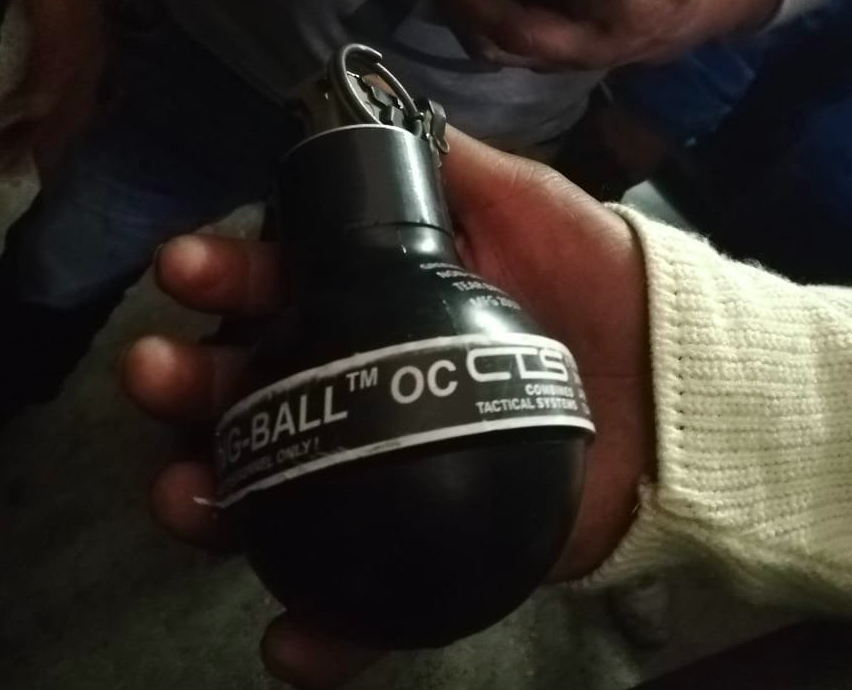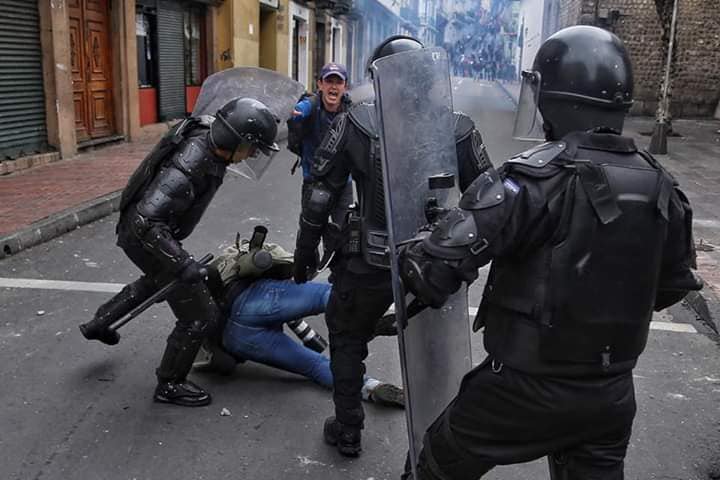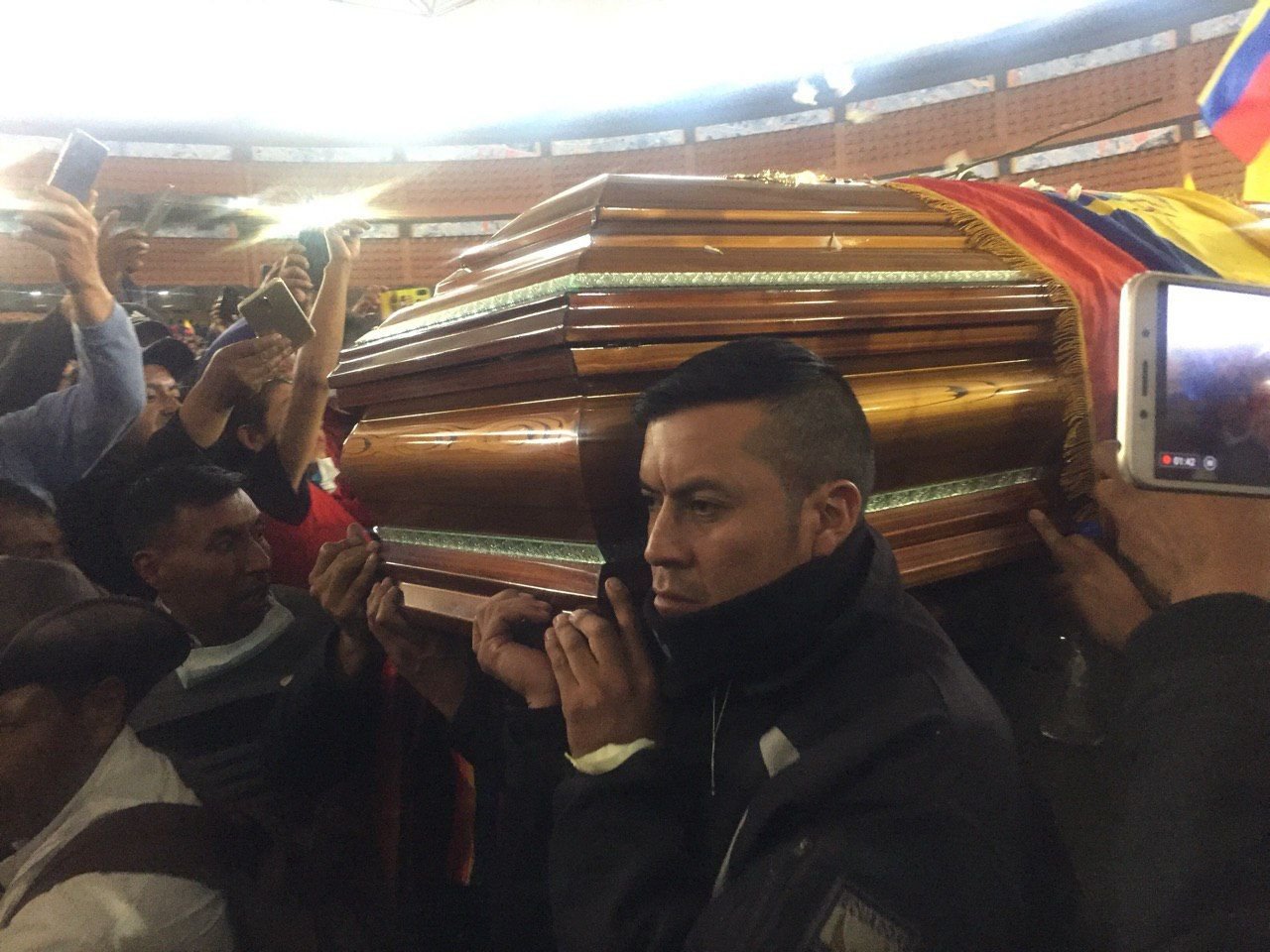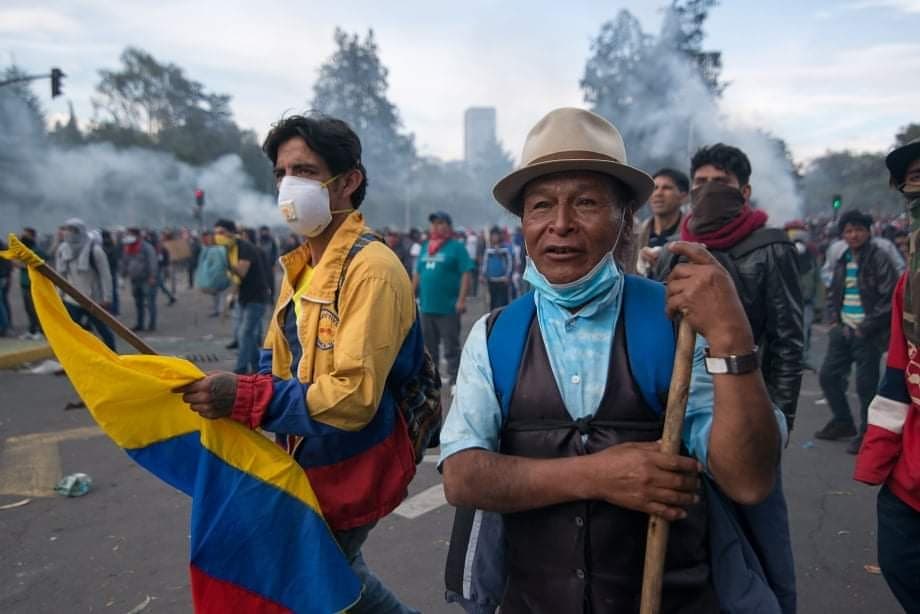During the recent 11-day uprising that shook Ecuador, parts of the capital Quito looked like a battle scene as police drove armed trucks through protest zones and fired tear gas and pepper spray at protesters, many of whom were women and children. The demonstrators wore gas masks laced with vinegar to filter the air, hid behind makeshift shelters and responded by throwing rocks and Molotov bombs.
In total, eight people were confirmed killed, 1,340 injured and 1,192 arrested, according to the Ecuadorian Ombudsman. The economy had also lost an estimated $3 billion, with two major export industries — flowers and broccoli — calling a state of emergency for their losses.
All of that came to an end last Sunday, when the government finally sat down with Indigenous leaders behind the protest and agreed to scrap a controversial IMF austerity package and work with civil society to create new ones — a move that has been considered historic.
But since then, the government has denied any undue force used by police, blamed outside conspirators for organizing a coup, made a series of arrests and proposed disputed new tax reforms that do not differ much from the old ones.
The United Nations human rights body, UNHCR, arrived in Quito this week to begin investigations into human rights abuses during the October protests.

Various groups have demanded the government take responsibility for the violence, and are working to hold police accountable for using repressive tactics against protesters. But the government has repeatedly congratulated the national police and armed forces for “strengthening democracy.”
As lawyer and political analyst Ramiro Aguilar said, Ecuador is going to see “grey days” ahead.
Origins of Revolt
The massive protests erupted on October 3, when President Lenin Moreno announced a series of labor and tax reforms to adhere with belt-tightening requirements connected to a $4.2 billion IMF loan. The reforms were referred to as Decree 883.
What really pushed people over the edge was the elimination of fuel subsidies that had been in place for 40 years. President Moreno insisted the cheaper fuel encouraged smuggling, and claimed the subsidies were costing the government up to $1.5 billion a year.
But for people on the ground, the price of diesel more than doubled and petrol increased by about 30 percent overnight. This also would have led to an increase in transportation fares and the price of goods in stores, in a country where minimum wage is $394 a month.
The average cost of living for a four-member family in Ecuador is already $714 a month, according to recent government figures, which does not leave much — if any — room for extra costs. Small farmers also said it put them at a disadvantage, as it would double the price of farming and transporting their goods to local markets.
Some of the other reforms that brought labor unions, students and women’s rights organizations out to protest included: a 20 percent cut in wages for new contracts in public sector jobs, a requirement that public sector workers donate one day’s worth of wages to the government each month and a decrease in vacation days from 30 to 15 days a year.
People also complained about tax breaks handed to transnational mining companies last year, and a tax amnesty that was granted to businesses earlier this year, which allows them to pay back outstanding taxes without paying the extra interest or penalties accrued.
Protesters said the burden of paying Ecuador’s debt was falling entirely on the lower classes.
Mapping Resistance
Transportation unions — taxis, trucks and buses — were the first to organize a national strike on Thursday, October 3, which brought the country to a stand-still. Taxis created roadblocks in the city, while truck drivers blocked highways and refused to carry out deliveries. After engaging in talks with the government, national transportation union leaders called off the strike on Friday.
But the protests were far from over. The same day transportation ground to a halt, protesters took to the streets everywhere from Cuenca and Guayaquil to Quito and rural areas. In most places, what began as peaceful marches were met by riot police who fired tear gas and pepper spray. In Quito, many witnesses testified that police were targeting and beating journalists.
Only four hours into the nationwide protests, the government declared a state of emergency and sent the army into communities throughout Ecuador. Despite increased tensions, protests grew larger with people responding to police by throwing rocks and Molotov bombs.
This would set the militant tone of protests over the following 10 days.
On social media, images began to surface showing police beating or running over protesters with their motorcycles. Others surfaced showing acts of vandalism by protesters.
Over the week, protesters in the cities, mainly students, workers’ unions and women’s rights groups, continued to organize marches that were met with the same police tactics of tear gas and pepper spray.
The same happened in the countryside, where the Indigenous movement responded by calling their own state of emergency, saying the police and army officials had entered their lands illegally. As a result, Indigenous groups detained over 50 police officers, saying they needed to submit to Indigenous justice before being released, a process that is recognized by the Ecuadorian constitution.
Indigenous and rural communities also blocked highways across the country, keeping the nation at a standstill for over a week. Communities in the provinces of Imbaburra, Chimborazo, Cotopaxi and Tunguragua blocked the PanAmerican highway, the main road that connects the north and south of the country through Quito. Creating barricades of burning tires, branches and other debris, communities blocked other roads from the coast to the Amazon. Protesters also took over six different oil wells, bringing operations to a halt.
Others took over the government buildings in capital cities in various provinces, including the Andean cities of Ambato and Guaranda, as well as the Amazonian city of Puyo. In the capital Quito, protesters briefly entered the National Assembly, but were quickly removed by police.

The dynamics of the protests began to change when the Indigenous movement started arriving to Quito on Monday, October 7, to support the national resistance and put more pressure on the government in the capital. As the week went on, some 15,000 Indigenous people arrived to Quito, many of whom walked or traveled in caravans. Many of the Andean Indigenous communities brought their families, which added hundreds of children, pregnant women and women carrying babies to the protests. Violent clashes occurred on a daily basis, while the government moved its operations to the coastal city of Guayaquil.
The growing Indigenous presence in Quito not only brought larger protest numbers to the capital, but it also brought back memories of Ecuador’s past, when popular uprisings, largely led by the Indigenous movement, led to the ousting of three presidents. These include the governments of Abdalá Bucaram in 1997, Jamil Mahuad in 2000 and Lucio Gutiérrez in 2005.
Despite comparisons to Ecuador’s past, Jaime Vargas, president of the largest Indigenous organization CONAIE, maintained that the intentions of the Indigenous movement were not to oust the president. They wanted him to respond to the needs of the Ecuadorian people, which meant calling off the state of emergency, reinstating the gas subsidies and scrapping Decree 883. For the Indigenous movement, the protests were also about fighting against the extractive industries in their territories, a fight that Vargas says has been ongoing for over 40 years.
Throughout the first days of protests, President Moreno invited Indigenous and other social movements to dialogue, yet remained firm in his refusal to reinstate fuel subsidies or roll back Decree 883.
Later in the week, Moreno finally agreed to reconsider the decree and Indigenous leaders then agreed to a dialogue. After four hours of negotiations on Sunday, October 13, the president scrapped the decree and agreed to create a new agreement with civil society, while Indigenous leaders called off the protests.
A Winding Path Forward
The Moreno government has long maintained that the IMF loan, and consequential austerity measures, are necessary after years of overspending by his predecessor Rafael Correa.
But the Ecuadorian economy was also hit hard by the low price of oil since 2014, and the appreciation of the US dollar during the same time period, which directly affected the dollarized regime. According to official numbers, the country’s total debt was about $55.6 billion as of April, 2019.

Andres Arauz, economist and former general of banking at the Central Bank of Ecuador, rejects the claim that austerity measures are the only way forward, saying there are other ways the country can get more dollars to pay back its loans. Implementing capital control measures, limiting dollars leaving the country by limiting unnecessary imports, administering trade and implementing tariffs and using domestic sources of liquidity instead of incurring foreign debt, are alternatives where the burden of paying back the debt will not fall on the Ecuadorian people, he says.
“We have to be very careful to not fall in the ‘there is no alternative’ narrative, which was a discourse or communication strategy that was highly used by the Thatcher and Reagan governments in the ’80s,” said Arauz, co-author of “Headwinds to Growth”: The IMF Program in Ecuador.
Analysts say Moreno’s government made several errors over the past month, particularly, bad communication about the reforms and not preparing citizens for major changes. Aguilar, a political analyst based in Quito, says Ecuadorians are especially sensitive to economic adjustments since the banking crisis in 1999, which left thousands homeless and caused over two percent of the population to flee the country.
Arauz says the government could have implemented mechanisms to help absorb the impact of lifting the gas subsidies, or made a slower transition away from subsidies, lifting them little by little over a longer period of time. Raising the price from one day to the next is “too hard for anybody that has to live from day to day,” he says.
It is likely that Ecuador passed the reforms quickly to meet IMF progress deadlines, and be able to receive another installment of the loan, he added. At the end of September, the IMF executive board said it was undergoing a second review of Ecuador, and if it approved the country’s progress in the coming weeks, it would give the South American nation $250 million, of the $4.2 billion loan.
“This is why they did it in such a negligent manner,” added Arauz.
Conspiracy and Denial
Since protests began, Moreno has said former president Rafael Correa has been orchestrating a coup against him. Moreno served as vice president under Correa, and was elected in 2017 based on continuing his left-wing platform. But weeks after the election, he broke with most of Correa’s policies.
From his home in Belgium, Correa denied any involvement in the protests, but did encourage Moreno to step down and call new elections.
Over the past week, Moreno has also accused several other groups of being involved in the coup orchestration along with Correa, including: the Revolutionary Armed Forces of Colombia (FARC), Venezuelan president Nicolas Maduro, the former armed gang the Latin Kings, and Russian intelligence.

Following the protests, three politicians with close ties to Correa were arrested, including Paula Pabon, elected governor of Quito. Several others have fled to the Mexican embassy to seek political asylum.
Aguilar, who is also Pabon’s lawyer, says protesters never tried to put anyone else in power and there is no evidence of an attempted coup. He added, the government is trying to shift the focus away from the violence it committed during the protests and details of future reforms.
Political analyst Decio Machado says it is possible that there were Correa infiltrators in the protests, causing havoc and trying to destabilize the government, but this was marginal compared to the high number of Indigenous and other protesters there with actual concerns. To not acknowledge that is to “not want to see the reality happening in the country,” he says.
Indigenous groups have repeatedly called for the resignations of Interior Minister Maria Paula Romo and Minister of Defense Oswaldo Jarrin, for their part in denying the deaths of protesters, human rights abuses by police and fueling violence during the uprisings.
The UNHCR will be conducting investigations into Ecuador’s violent protests from October 20 to November 8, while the Inter-American Commission on Human Rights, IACHR, arrive on the 28th of October.
The government says it is still working with Indigenous and social movements to create new reforms, but many are skeptical that the government will move away from similar austerity measures.
The IMF’s Role
Earlier this week, the three largest Indigenous organizations of Ecuador, the CONAIE, CONFENAIE and Ecuarunari, sent a letter to the IMF, saying its “insistence of stubbornly applying austerity policies not only ignore the complex realities of our peoples, but also ignore, universally, our priorities.”
It also questioned the international lending body’s sense of urgency and economic judgement. Ecuador has lost billions of dollars in tax revenue through business friendly tax amnesties, corporate debt forgiveness, and corruption, all under the guidance of the IMF.
“A good financial advisor would tell us that before going out to ask for loans, let’s stop giving money away,” reads the letter. It also emphasizes that all changes and policies should be agreed upon “with the people, not decided behind their backs.”
By last week, Moreno had already released a new tax reform bill, saying it was in response to the demands by protesters. “We ask those who have more to pay more,” tweeted Moreno.

Some of the new changes include a tax on companies with annual revenue of more than $1 million, while citizens with annual income above $100,000 will not be able to deduct personal expenses from their income tax.
But Arauz says that rather than tax reform, the majority of the 200-page document is taken up with financial deregulation proposals. These are much more political in nature, he says, as they seek to reverse various controls that former president Correa put on the banking sector in response to the 1999 crisis, when the deregulated banks notoriously overspent and helped plummet the economy.
Reversals in the new bill include: lifting mandatory domestic investing for Ecuadorian banks, which was put in place to keep money within the Ecuadorian economy; allowing banks to invest abroad without restrictions; lifting interest rate ceilings; and deregulating financial service fees and commissions that banks charge their customers. It also includes moves to make the central bank more independent, even though in the Constitution it is defined as an office of the government.
“It’s explicitly unconstitutional,” said Arauz. “This has nothing to do with the fiscal deficit or the public finances but it is the underlying structural transformation of the Ecuadorian economy to the neoliberal model.”
On the bright side, he adds, the protests probably helped lift a bit of pressure the IMF was putting on Ecuador to pass quick reforms and achieve end-of-year targets.
“They’re having a few consecutive strong blows in Latin America, so they probably want to at least save face in the region,” says Arauz of the IMF, “they already failed catastrophically in Argentina and now they’re witnessing what’s happened in Ecuador.”
As one protester said the night uprisings came to an end, if the government doesn’t comply with his promises to work with the people, “we’ll come back with more force, and the president knows this.”
This article was co-published by Toward Freedom and ROAR Magazine.
Author Bio:
